|
Pike perch is a welcome trophy for any fisherman. They catch pike perch using live bait and artificial bait. And the pike perch does not take a bait of plant origin.
Zander caught all year round... He will never disregard a spoon in his field of vision.
Spoons for pike perch
It is believed that the most suitable for fishing zander are narrow, elongated spoons, widened downwards. Which spinners are actually the best when fishing for zander, oscillating or spinning, is a moot point. Some anglers believe that the bait is an ineffective bait. But anglers of the older generation, who fished in those days when there were no other spinners at all, have a different opinion. However, it all depends on the time and place of catching zander.
Pike perch on a spoon in spring
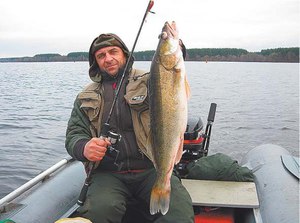
As soon as the water breaks open from the ice, you can start catching zander.
Experienced anglers find lure to be the best bait for pike perch in the spring. Most often, a spinning spoon (front-loaded spinner) is used during this period. During this period, the water begins to cloud. And since these baits are noisy, the pike perch hears them very well. Therefore, they are recommended to be used from February until the pre-spawning course of pike perch.
The best period for catching zander is from about mid-April to the end of the first decade of May. During this period, the zhor of pike perch begins. Perhaps the best biting for the whole year is observed at this time. And fishing during this time can be very successful. After May 10, if it is possible to catch a pike perch, then only a medium-sized one, weighing no more than 600 g.
Pike perch for trolling in summer
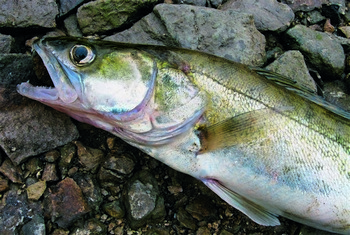
In summer, pike perch is caught at early dawn and late in the evening. During the day, he takes very rarely. In the second half of summer, the most successful night fishing is considered to be on the shallows and spits. At other times, you will not find pike perch in these places.
The best lure for walleye at that time was a narrow, light-colored lure.
Zander often ambushes. Therefore, the spoon should be driven slowly and smoothly. If zander is caught from a boat, then it must be stable, since a large zander caught on the hook can resist.
Pike perch on a spoon in autumn
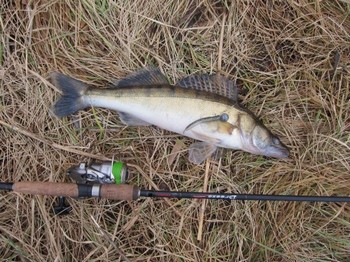
Autumn fishing for zander begins at the end of August. At this time, he is already thinking about the places of future wintering and begins to shift to a depth. Beginning in October, the autumn fever sets in, which lasts until mid-November. Of course, the biting at this time is worse than during the spring zhora, but still it is a great time for those who like to catch pike perch. At this time, he takes better from the day. Therefore, lovers of spoons give preference to heavy oscillating spoons.
In November, the activity of pike perch decreases sharply. But, if you're lucky, you can get a fairly large specimen.
Pike perch for trolling in winter
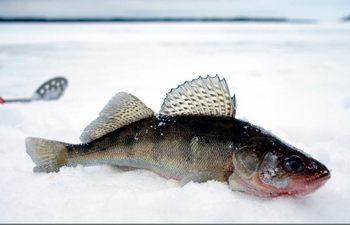
In winter, they begin to fish for pike perch when the ice on the reservoirs becomes quite strong. It bites best at morning and evening dawns, although it can bite on clear frosty weather all day.
In order for fishing to be successful, you need to choose the right place. Experienced fishermen begin to drill holes, moving from shallow to deeper places of the reservoir. They also start fishing from shallow depths.
The mouth of the pike perch is not wide. To catch it, use narrow spoons 10-15 mm wide and 6-12 cm long, made of white metal or brass. They can be matte or shiny. Good results on winter fishing are given by spinners made of two metal plates glued together or connected with rivets. Such spoons are made by amateur craftsmen.
There are many ways to lure pike perch. But in winter, the best is considered to be a sheer spinning.
During the summer months, especially in hot weather, catching predatory fish can be difficult. When the water temperature is too high, predators can simply go to the bottom, and for a certain period they eat quite little. However, with the right fishing time in the summer, you can also get a good catch. Zander fishing in summer is especially successful for several weeks. At the same time, do not forget about the possibility of night fishing, because pike perch remains active in warm water even in the dark, and some anglers are convinced that it is at night, with the right approach to business, that it is easiest to catch several trophy specimens. The most effective ways summer fishing is considered spinning, as well as fishing with float rod on live bait. The most popular baits for catching this type of predator are edible silicone and wobblers, spinners are used a little less often. Zander tackle in the summer should work well with edible rubber and wobblers. For this purpose, spinning rods of fast, as well as ultra-fast action are best suited - such blanks allow not only to make high-quality postings of such lures, but also provide reliable striking. After all, the mouth of the pike-perch is quite bony and hard, fishing rods with relatively soft tops do not always cut through it (however, the hookup to a large extent depends on the sharpness of the hooks). The length of the rod depends on the conditions on the pond and the method of fishing. When fishing from a boat, or when fishing for zander on a small river, the length of the spinning rod will be about 2 meters. But if coastal fishing is planned in a large reservoir, then it is advisable to have a long form, from 3 or more meters, which will allow you to reach promising points. The fishing time should also be taken into account - at night, pike perch, as a rule, goes in search of prey in shallow waters, which means that relatively short rods are suitable for large water (with which it will be much easier to move along the coast in poor visibility conditions). The test depends on the strength of the current, the lures used, and in part on the size of the intended prey and the fishing distance. If the pike-perch places are located far from the coast and there is a pronounced current, then rods with a test of up to 30-40 grams may well be needed. In calm water and at a short distance from the coastline, 15-20 grams will be quite enough.
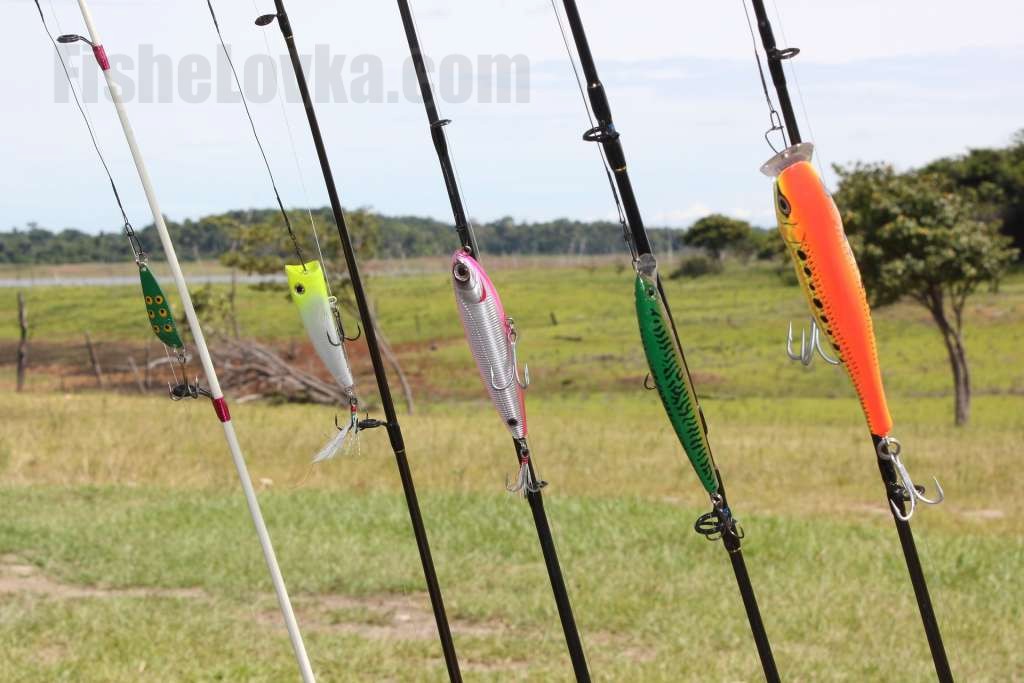
Photo 1. Spinning rods are ready for battle. Reels, line and leader materialMost often used are non-inertia tubes ranging in size from 2000 to 4000. Requirements for the quality of reels may differ slightly depending on the rods used. So, for example, a budget grinder is quite suitable for a light class rod, since in most cases such bezinertsionki work quite tolerably well with not too thin mono-lines and cords, and also have sufficient reliability. However, if an ultralight spinning rod is used, then in the budget price category it may be impossible to choose a reel suitable for it, since inexpensive models often do not cope well with laying thin and ultra-thin lines. Therefore, fans of fishing with ultra-light tackle have to buy expensive products from famous brands. You can fish in this way both during the day and at night. Most often, the following types of fish are used as live bait: - Verkhovka.
- Gudgeon.
- Loach.
- Goby.
- Rudd.
They try to select live bait taking into account the peculiarities of the structure of the pike perch pharynx. Since it is relatively narrow with him, then preference should be given to fish with an elongated body shape.
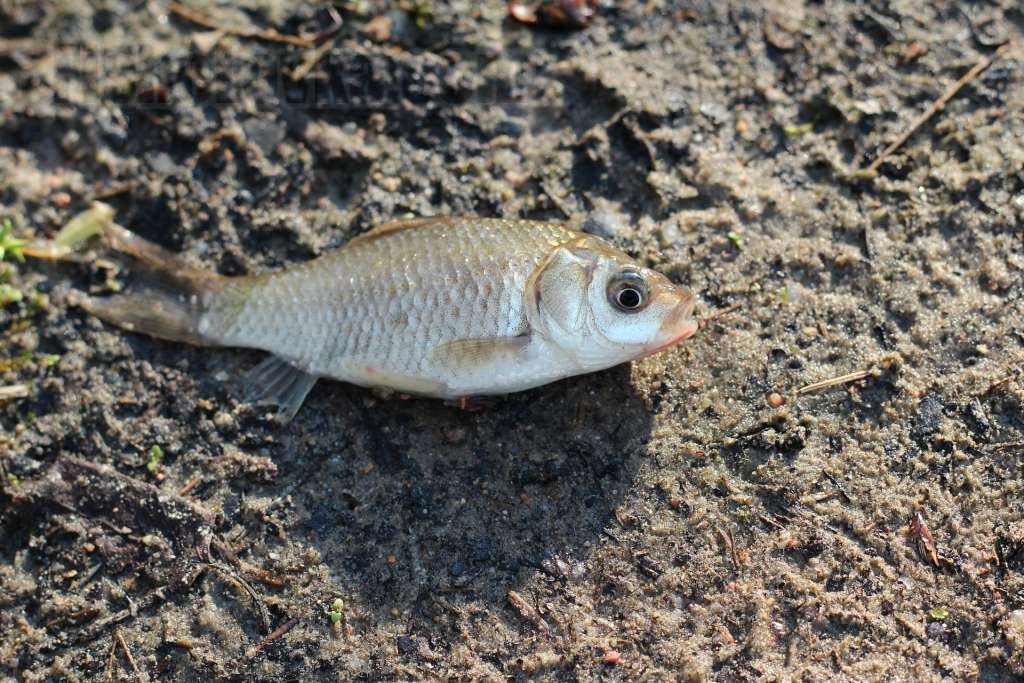
Photo 2. Karasik is also a good live bait for pike perch. Used baitsArtificial ones are selected taking into account its anatomical features. Of the wobblers, preference should be given to models with a minnow type body shape, since they are most similar to the natural prey for a fanged predator. As a rule, they have a large enough blade that allows them to go deep enough (although this is not necessary, options with a small penetration are also suitable at night). Also at night you can apply and. If during the day the pike perch is found mainly at a depth, then going out to the shallows at night, he may well pay attention to the gurgling of this bait. Very often, both day and night, edible silicone is used. They use mainly baits with an elongated body shape - vibrotails, worms, slugs. However, fanged often responds well to imitations of crayfish, as well as to various creatures.
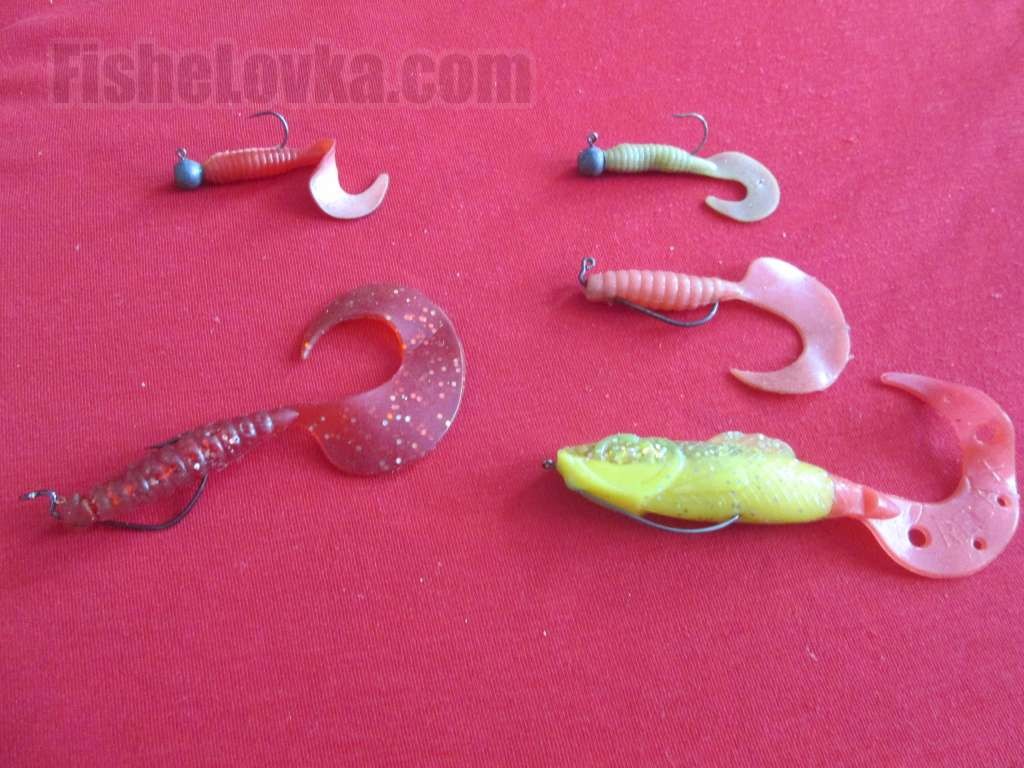
Photo 3. Silicone for jig. Fishermen are attracted by the good catchability of such lures, the possibility (due to the porous structure of the material) of impregnation, as well as the low cost of such products, which makes it possible to fish in tightly coiled places, not paying attention to frequent breaks. Spoons in Lately are used somewhat less frequently. As a rule, these are oscillating models of an elongated shape, or spinners of the "Castmaster" type. Turntables are used less frequently. The color of the baits is selected based on the following pattern - for pure and transparent water, darker and more natural color options, in muddy water, as well as on cloudy days, you can use bright options. For night fishing, both wobblers and edible rubber painted with light-accumulating paint are often used.
Important! When fishing for pike-perch, it is not worth saving on hooks, since even sharp expensive hooks sometimes pierce its bony mouth with difficulty. When using cheap Chinese products, the number of successful sweeps will be much less.
Features of catching walleye at night and daytimePlaces that can be fished for zander bite differ significantly depending on the time of day. In the afternoon, it is worth looking for a fanged in deep places- at the exits from pits, in pits, near the edge, as well as not far from any unevenness in the relief, if they are located at a sufficient depth. However, by the evening the situation changed. goes hunting on the coastal shoals. Sand spits, shallow rifts, as well as near bridges and other water structures. At the same time, the maximum activity of pike perch falls at 10-11 pm, midnight, as well as the predawn hours. Going on a night fishing, do not forget about the necessary additional equipment. It is worth taking with you a hand-held, as well as a headlamp and a small supply of batteries for them.
16
Catching pike perch from ice 12/04/2013 Winter trolling of a predator from ice is a fascinating, reckless and prey method of fishing, which brings the angler, in addition to ... →
Spoon for pike perch
Description of lures
It is difficult to say when the bait first appeared and who its alma mater is, but, for sure, this is the oldest artificial bait invented for fishing. Therefore, there are a great many varieties of this bait today.
Weight, size, shape, color, oscillating and rotating - the spoons have quite a few differences, but these lures have and common feature- all of them are made of metal and all are designed to catch fish and give their owner unforgettable moments of fighting a trophy!
Various types of spinners, their differences and features.
First of all, it is worth dividing all the spinners into "oscillating" and "rotating", as well as "winter" and "summer". However, the latter division is not due to the temperature of application of these baits, but to their performance. In other words, we call “vertical” lures “winter” baits, and “summer” ones - “horizontal” ones. However, fishing does not belong to the exact sciences, and much in it is rather arbitrary, including such a division. Jigs (heavy vertical spoons) successfully catch fish from the sides of boats, and some oscillating "summer" spoons, in particular, "triangular" and "castmasters", perfectly pull fish out of holes in the ice.
But if it is quite difficult to draw a clear line between "vertical" and "horizontal" lures, if at all possible, then with "oscillating" and "spinning" lures, everything is much simpler. The first type is created, as a rule, from a single piece of metal (excluding fittings), and, during wiring, makes oscillatory movements from side to side. The second type of bait has much more elements in its design, including an axis and a petal. When posting such a bait, the petal rotates around the axis of the spoon, which is why it got its name.
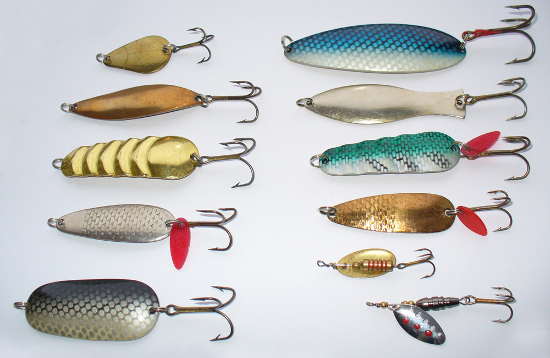 Catching zander with winter (vertical) lures
It is impossible to name a specific model of a spoon that would catch pike perch always and everywhere, for the simple reason that there is no such bait. In different bodies of water, a predator sometimes prefers completely different spinners, moreover, its priorities can change significantly with changes in the weather, changes in the strength of the current, time of day, and God knows from what else. Often, fishermen manage to find a spoon that regularly brings good catches throughout the season, but the season ends, and after the next freeze-up, it turns out that last year's favorite is completely uninteresting to the "fanged" one. And the best, when fishing for walleye with lures, will have the maximum possible arsenal of various baits. However, this does not mean at all that the true "gossander" carries with him two backpacks of spoons. A fisherman who knows the pond and the conditions for fishing in it can easily get by with just a dozen or so spinners. By freeing his box of lures that are too light and too heavy, not suitable for the places where he is going to fish.
Fishing for walleye, like fishing for many other fish, begins first of all with a search, which is best done collectively. Pike perch is a schooling fish, and in winter its schools are very impressive, therefore, if you still manage to find this predator, there will be enough fish for everyone. As soon as it is possible to catch the first "fanged", the water area near the successful hole is drilled out in all directions, which makes it possible to determine where the concentration of the predator is the most dense. In addition to the convenience when searching, collective fishing also helps to track the movement of the zander pack. It is often very clearly seen how in a dense crowd of fishermen some edge of this community stops catching a predator, and on the other side, opposite, there are more bites. This suggests that the predator's flock has shifted, and less fortunate anglers are moving in the direction where the bites continue. Thus, fishermen and their prey manage to move in the same direction, almost synchronously, some above the ice and others below it. Agree, it will not only be many times more difficult for a lone fisherman to find a predator, but it will also be almost impossible to predict in which direction the school of fish is heading. The pluses of collective fishing can also be attributed to such a moment as the selection of the spoon and its color. Sometimes the pike perch is practically "omnivorous", and other times it prefers a certain color of the spoon, and in a dense fishing crowd this preference becomes clear in a matter of minutes. After that, the whole team switches to fishing with the "correct" color.
Among anglers there are also those who do not recognize natural bait at all, believing that catching a predator with an artificial bait is "aerobatics" in fishing. I will not confirm or dispute their opinion, but when fishing for zander in winter, even the most zealous opponents of "natural" often compromise with their principles. Pike perch, perhaps like no other predator, very often reacts positively to various replantings. It can be either whole fry or their pieces, and sometimes it is enough to hook the spoon on the hook with just the eye of a dead fish, in order to multiply the number of bites. It happens that there are no bites at all on a "naked" lure, but on a bait with a boost, bites follow one after the other. And if, when attaching small parts of fish to the bait, the color and shape of the spoon still has some meaning, then when attaching whole fish, only its weight matters, and the spoons are often replaced with large jigs or ordinary jig heads.
Catching zander with summer (horizontal) lures
The most difficult thing is to catch fish where there is none. Therefore, in the warm season, as well as in winter, fishing for zander with spinners begins with the search for this fish. And in order for the search to be as effective as possible, you need to know the habits and habits of the above-named predator, to have an idea of the places where the pike perch feels most comfortable. Such places include: submerged snags, channel edges, places with a hard rocky bottom, as well as various changes in the bottom relief. In reservoirs without a current, pike perch can be found almost everywhere, but nevertheless, this fish often chooses places with decent depths and tries to avoid areas with a silted bottom. In rivers, pike perch is easiest to find in pits, on the edges of the fairway, next to the shell rock.
With the onset of darkness, the "fanged" often, in search of prey, goes to the shoals and shoals, where sometimes it organizes a very noisy hunt. Having found such a place for a nighttime "feast" of pike perch, it is most likely to use spinning spoons that can hold the stream well and work without interruptions in the upper layers of water. Good results can be achieved in a similar setting and with swaying spoons, but again, the shallow water bait should not be heavy.
But when hunting for pike perch in the bottom layer, at decent depths, "heavyweights" spinners are used. If this is a plateau without serious changes in depths, then not only "spinners" with a weighted core, but also oscillating spoons are quite applicable. The latter can be carried out both evenly and with pauses, using the options of a jig step during wiring, or wobbler "stop-and-go" and "twitching". If the fishing takes place in a place with a significant difference in depth and various irregularities, then in such a situation, the efficiency of uniform retrieval significantly decreases. And instead of spinning spoons with a classic weight, it is better to use "spinners" with a front weight, which are able to maintain the rotation of the petal even during pauses, sinking to the bottom.
And, of course, one cannot fail to mention the snag, so beloved by pike perch. "Fanged" simply adores such places, and submerged stumps and tree trunks adore our baits. Fishing in a location like this can cost a lot. a short time fairly thin out the arsenal of baits, in order to avoid unplanned losses, it is better to use different kinds"Non-sticky":
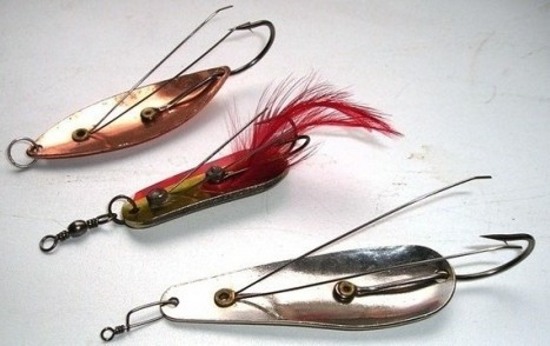 The implementation of bites, when using lures of this type, is somewhat lower, in comparison with baits, the hooks of which are in no way protected, but the losses, when hooked on snags, are several times less. And the worst realization, due to the opportunity to hold the spoon in a "strong" place, will be more than compensated by the increased number of bites.
It will also increase the number of bait attacks, and successful sweeps, the correct choice of the size of the spoon. The mouth and throat of pike perch are relatively small, which is why narrow-bodied fish are more often present in the "menu" of this predator. Accordingly, the bait should be matched to its main catch. That is, not too wide, otherwise, the zander can either ignore the bait, or simply hit it, but not enough, which will lead to a large number empty undershoots.
Making spinners for pike perch with your own hands
Taking on the independent production of spoons, anglers pursue, first of all, two goals: saving their budget and replenishing the arsenal of baits with exactly those spoons that the best way suitable for specific fishing conditions.
With all the diversity of the world of spinners and the seemingly huge selection of baits in specialized stores, it is sometimes extremely difficult to find exactly the type of spinner you need. Winter and wavering spoons often turn out to be either too light, or too bulky, and good "spinners" with a front load, or with a core weighing fifty grams, and at all, one or two and missed. But I also want to experiment with color, try different variants bends, different shapes and numbers of petals ... And there comes a time when the angler no longer relies on eminent manufacturers and various retail chains, but takes sheet metal, a hacksaw, a file, a soldering iron in his hands and begins to create. Of course, the adage about the first pancake is also relevant when making spinners, someone, after a while, with a smile, demonstrates their first products, someone alters them, while others manage to create a good "working" bait the first time. But each of them will say with confidence that there is no greater pleasure than catching a fish with a spoon made with your own hands.
The easiest to manufacture are winter vertical spoons, with them it is worth starting to master the art of creating metal lures. And for those anglers who are not fond of fishing for pike perch from the ice (and there are some!) It is better to start with oscillating spoons, which, in terms of their main design characteristics and manufacturing methods, are very similar to winter vertical spoons.
For the manufacture of winter lures, in addition to patience and tools (hacksaw for metal, files, file, drill, soldering iron, etc.), you will also need the main consumable material - sheet metal. Which one? Almost any will fit, moreover, at the first stages of mastering the independent manufacture of baits, the more choice there is, the better. Stainless steel, copper, brass, cupronickel - these are the metals most commonly used by DIY anglers. Thickness from the thinnest (for bimetallic lures and lures with tin) to 3-5mm .. Applying one or another metal for the manufacture of identical products, you can change both the color of the bait and its weight, which is very important.
Sometimes pike perch prefers white lures, on the next fishing give him copper or brass, and guess what he wants on the next fishing trip. A home-made fisherman does not guess, and when it is difficult to determine what color a predator prefers today, he offers him his own product - a bimetallic spoon, a very catchy and simple bait to make.
To create the above spoon requires two types of thin sheet metal, from which two identical blanks are cut, of the required size and shape. Then the metal plates are cleaned, tinned and welded together. The bottom of the lure may contain more tin, which will make it heavier and give the lure the right balance. The hook, on such a spoon, can be both soldered and suspended, for which a hole is drilled in its lower part for the winding ring or a loop is soldered, in the same way the spoon is attached to the fishing line.
But the soldering method is not the only way creating a bimetallic spoon, moreover, not all metals can be connected in this way. And when the soldering iron is powerless, a drill and rivets come to the rescue.
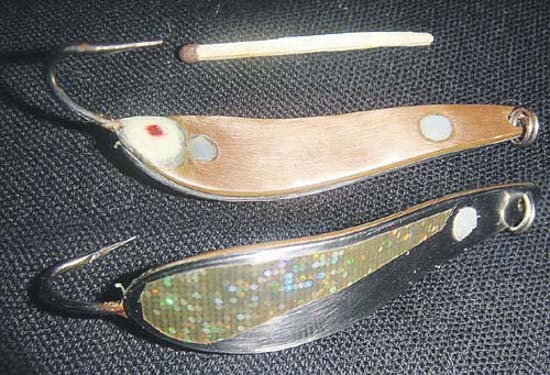 The workpieces can be riveted both motionlessly and in such a way that a gap remains between them, and the plates themselves remain mobile. The latter option can also be performed using a pair of winding rings, one of which will connect the plates in their upper part, and the second in the lower one. A hook and line will be attached to the same rings. However, the connection with winding rings is more suitable for the manufacture of horizontal oscillating lures with a larger area than winter "verticals". With the movable version of the connection of two plates, they, during wiring, hit one another and create noise. There is no scientifically proven evidence of the effect of this noise on pike-perch, but many anglers claim that such a clang of metal plates additionally attracts a predator.
 The creation of a classic spoon, consisting of one, solid, piece of metal is identical to the manufacture of bimetallic bait, and, conventionally, twice as simple, since only one blank is required.
Oscillating spinners, in their manufacture, are no more difficult than their winter counterparts, but do not forget that with an increase in the area of the bait, the rigidity of the entire product decreases, and you should not use too thin and soft metal. Otherwise, the spoon can change its shape even under the influence of the jaws of the next predator, because of which it will lose its "game" and can turn from "catchy" to "inoperative." Of course, it will not be difficult to give it its former shape, but on a fishing trip it is better to catch fish, and not to search for the desired bend of the bait.
Making spinning spoons for pike perch is somewhat more difficult than creating winter and oscillating spoons on your own, but no less interesting. The difficulty lies in the fact that the spinner in its design has a fairly significant number of elements, the main of which are the axis and the petal. Accordingly, for the manufacture of spinning lures, you will need additional material- not thick, but tough stainless wire. And also: glass and metal beads, various weights with a central through hole, cones (acting as a bumper) and all the same sheet metal, but already up to one millimeter thick.
A spinning lure is just that "bicycle" that is unnecessary to invent, but it can be improved and adjusted to certain conditions. That is, you should not waste your time and material on the invention of new forms, since the world's best manufacturers have long ago done this for us. “DIYers” with experience do just that, taking as a basis one or another design of a well-known bait, create its likeness, but with its own weight, size, color. And such a bait, as a rule, turns out to be more catchy than its eminent prototype. Because it is created not for the American bass or Finnish salmon, but for the pike perch, from a specific river or reservoir, and sometimes even from a strictly defined pool or rift. In addition, in addition to physical characteristics, there are others that cannot be measured or weighed. When creating a spinner, the angler puts a piece of his soul into it, charges it with his energy, and believes that this particular bait will be impeccably catchy. And, as you know, belief in bait and luck are one of the main components of successful fishing!
The unsurpassed taste of white pike perch meat has made it a fish delicacy. This fanged freshwater predator is good at hiding and is not easy to catch. It is the excitement of the struggle that makes it a desirable prey for many experienced spinning players, and novice fishermen are not averse to hunting it.
This type of fish is commercial and is found in the basins of rivers of different seas on the territory of Russia. The standard weight of an adult pike perch reaches 4 kg, but sometimes there are oversized, which weigh up to 10 kg.
If you compare pike perch with pike, then you can identify some similarities appearance fish. Common are a pointed nose and an elongated body. But the pike-perch surpasses the well-known river predator in gluttony and excitement of the chase and can continue to kill, although it is already full. The back of the fish is colored greenish; from it there are dark stripes along the gray sides almost to the white belly. The dorsal fin is very hard, with spotted transverse plates; the rest of the fins are dark gray in color. The predator's eyes are bulging, purple with a blue tint, able to see in the dark during night hunting.
Due to the fact that the emissions of harmful substances into rivers are gradually increasing, the number of zander is gradually decreasing in natural environment... Fish of this species can live only in clean and flowing water. In our years, many fish farms have appeared, where they are engaged in the cultivation of pike perch, creating favorable conditions for it, since this fish is by value second after red fish... There are such types of pike perch that can live alternately in sea and river water:
- common pike perch;
- sea pike perch;
- bersh;
- light-feather pike perch;
- Canadian pike perch.
Fish meat is considered a truly Russian delicacy. It has long been salted, boiled, fried and baked. And caviar, for some reason, has taken root more in the cooking of Asian countries, where it is very much loved and appreciated for its high content of trace elements and vitamins that are useful to the human body.
 The negative thing about catching walleye is that it should be hunted only at night with poor visibility, which reduces the correctness of casts and maneuvers with fish caught on the hook. A successful evening bite begins only at dusk, and the morning bite is progressive in the predawn haze. Catching a walleye in the middle of the night or during daylight hours is possible only by chance and not very often. The negative thing about catching walleye is that it should be hunted only at night with poor visibility, which reduces the correctness of casts and maneuvers with fish caught on the hook. A successful evening bite begins only at dusk, and the morning bite is progressive in the predawn haze. Catching a walleye in the middle of the night or during daylight hours is possible only by chance and not very often.
Zander is caught from the bottom, after a fight on the water surface. You cannot catch fish during the battle. Since the predator usually rarely swallows the bait, but clings more to the bony jaws or mouth cavity, then when the bait is gripped, it must be sharply cut. After hooking, it is advisable to quickly move it from its place so that it does not have time to go into stones or driftwood. If this happens, you can raise it from its place by tapping on the rod. Pike perch does not resist for a long time, dexterity in defense is unusual for him. He can spin in place and shake his head violently. If you bring him to the shore, you can sometimes see a strong beat on the hook. But as soon as he half-pulls his body out of the water, he immediately calms down. Usually he is released into a kukan with water, where he gradually falls asleep, and if left on the shore, the fish will turn off in a few minutes. Care should be taken when removing it from the hook to avoid puncturing your fingers.
General points of catching walleye
- it is easier to catch a predator than to find one;
- its activity occurs during spawning and early autumn;
- the decrease in bite occurs in the middle of summer;
- you need to learn how to cut sharply in order to pierce a hard jaw;
- the pike perch is in constant motion, and the fisherman also needs to follow it.
Search for habitats
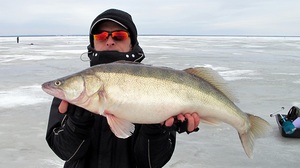 There are walleyes in the river pits of the fairway or in deep places with a clay bottom. He loves to live in places of sunken snags and parts of trees, bottom stones. A favorite place can be considered whirlpools, the vicinity of dams. In roast summer time the fish rises from the pits, where there is a lack of oxygen and stands in medium and sometimes shallow water. There are walleyes in the river pits of the fairway or in deep places with a clay bottom. He loves to live in places of sunken snags and parts of trees, bottom stones. A favorite place can be considered whirlpools, the vicinity of dams. In roast summer time the fish rises from the pits, where there is a lack of oxygen and stands in medium and sometimes shallow water.
Usually, one flock of pike perch lives in a lake or section of a river, which periodically bypasses all places for food. Predators can move around "fishy" places in different time days. You need to catch zander at a depth of more than 4 m, perch and pike are caught higher. If you rely on luck and catch blindly, you first need to find the location of the flock using a heavy spoon and strong line, and then fish with the chosen bait.
Summer spinning
In the summer, flocks of predators consist of fish of almost the same size and do not count many individuals. The effective period for catching pike perch is considered to be the time after spawning, the beginning of which begins in mid-May and lasts about a month. Sometimes spawning due to unsuitable weather can drag on for the whole June. After the end of spawning, there is a strong bite for two weeks, then it very weakens.
When fishing, you need to monitor the condition of the water, if it is susceptible to pollution by algae, then it is not recommended to use braided line, since adhering plants will make it heavier and it will be impossible to feel the grip of the fish. Often large individuals, hunting alone, successfully avoid the hook, in order to catch them, you should bomb holes with sharp jumps in depth.
Fishing in autumn
Back in summer August fish bite starts to improve, and it becomes strongest in September. October is characterized by a gradual decrease in intensity. V best case this situation lasts until the beginning of November, then abruptly ends. Small flocks grow larger and go to great depth and you need to catch them with deep special lures.
Description of lures for walleye
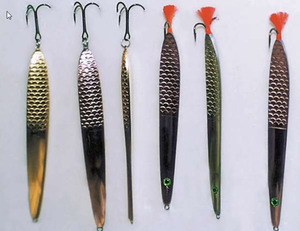 It is very difficult to answer the question about the time of the appearance of these devices, the only true fact is the antiquity of this invention. Nowadays, they come in many varieties in size, color, shape and mode of movement. A common feature we can assume that they are all made of the same material, which is metal. It is very difficult to answer the question about the time of the appearance of these devices, the only true fact is the antiquity of this invention. Nowadays, they come in many varieties in size, color, shape and mode of movement. A common feature we can assume that they are all made of the same material, which is metal.
Lures that have elongated and narrowed shape, resembling bleak in shape. Small wooden fish have also worked well. Pike perch bites perfectly on live bait (gudgeon, bleak, small dace). Wide fish (small roach and podleschik) are not used, since the pike perch has a narrow throat, and it will not be able to swallow such bait.
Lures for summer fishing
For fishing in the summer, use a horizontal spoon. Pike perch is considered to be one of the species of fish that eagerly pounce on the bait you like, therefore, in the summer, universal spinners are well used, which are successfully used when hunting for pike and perch. Mainly spoons for walleye should be streamlined and have a good weight. This will solve the problem with long-range casting and will allow you to carry out the wiring along the bottom.
The surface of the spoon is chosen depending on the transparency of the water, the degree of illumination of the place of fishing. They produce baubles coated with varnishes and paints, and also use galvanic spraying. The baubles can be smooth or grooved in relief. The bait should be perfectly balanced and very accurate. This adds to the efficiency of its use in different waters.
As a spoon for walleye in summer period a rotating version is available. This is the optimal solution for attracting the attention of a predator by turning the petal. Although such a spoon tempts the fish, it clings very strongly to all driftwood and pitfalls, since fishing takes place close to them.
Winter types of lures
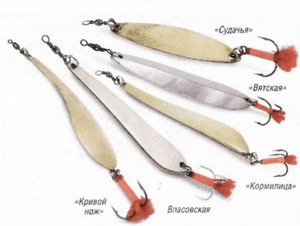 In order to cold period under the ice to find the desired individual, the fisherman should walk more than a dozen kilometers and drill many holes in the ice. There is simply no time to wait for a long bite near each hole. In such cases it is good to use vertical bait type with a swinging motion. In order to cold period under the ice to find the desired individual, the fisherman should walk more than a dozen kilometers and drill many holes in the ice. There is simply no time to wait for a long bite near each hole. In such cases it is good to use vertical bait type with a swinging motion.
Such a spoon should be of a decent weight, falling type with a bottom rump. Used in manufacturing whole piece metal, not counting the fittings, and when guided along the bottom, the petal makes a soft vibrational motion. Some anglers believe that such spinners are a thing of the past and consider this bait to be completely ineffective. But for ice fishing in winter, such spinners are simply irreplaceable and work much better than rotating ones.
Lures are in high demand, which have a small width and no more than 10 cm in length. Other baits are used for leashes, depending on the characteristics of the reservoir.
Spinner type
By design, such spinners have many different elements. The main ones are spinner axis and its petal... When carrying out the wiring, the petal from the resistance of the water begins to spin around the wire, hence the name.
Many fishermen of the old school, who do not closely follow the trends of fashion, have not learned how to catch zander with a spinning bait. This is because it is possible to hunt a predator with ordinary turntables only during the period when it is most active in the shallows. But if you take a rotating type with a front rump, then the possibilities of using such a spoon are significantly expanded. They are becoming popular because they perform well in vertical drop and horizontal bottom sweeping. They can be safely attributed to universal lures.
Another advantage is considerable weight, which allows them to be cast over long distances. Fishing is often carried out on a pond of significant size, and the use of such lures will allow you to study the places of possible habitat of pike perch from one stop and catch it on a spinning rod.
A spinner with a front rump is one of the excellent lures, with its help they make a stepped type of posting, which is considered the most effective for catching a predator. Strongly attracts the attention of the zander spinner, which simultaneously rotates and falls. An increase in the possibility of fishing arises if you lead such a bait along the bottom of the reservoir.
In order to reduce the possibility of a hook of this type of spoon, it is recommended to use a double hook rather than a triple hook. This will reduce negative qualities such a spinner and will allow it to cling less to driftwood.
There is another type of bait, in which the weight is located on the axis line. This species shows very good results in fishing in the morning and evening dawns. Pick up predator bait follows, based on the principles:
- weight of a spoon for walleye;
- the color of the fixture;
- the shape and characteristics of the river or lake;
- weather conditions, water temperature, illumination.
Making baubles "Turbinka" with your own hands
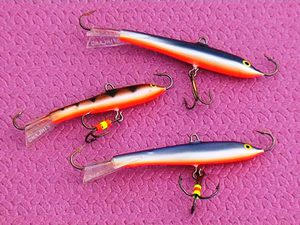 Such spinners are found in fishing shops oval or elongated with a surface treated with a matte or shiny composition. The spoon is effective in the evening in poor lighting, or applied on a cloudy day. For branded models of this type, you will have to pay a lot of money in the store, but it is much more interesting to make at least one spoon with your own hands. Such spinners are found in fishing shops oval or elongated with a surface treated with a matte or shiny composition. The spoon is effective in the evening in poor lighting, or applied on a cloudy day. For branded models of this type, you will have to pay a lot of money in the store, but it is much more interesting to make at least one spoon with your own hands.
Materials for making spinners
- thin wire, you can use a paper clip;
- triple hook of the selected size;
- thin and soft metal plate, the surface of a tin can can be used;
- small bead;
- a piece of lead;
- tools for working on metal.
Manufacturing technology
Initially, a petal template is made from cardboard or paper. It is applied to the metal of a tin can and cut exactly along the contour. The edges are filed to eliminate irregularities.
Drill two holes to install the wire axle, they must be chamfered for free rotation. The hole surfaces are bent at an angle of 90 °. The tee is attached to a ring of wire, which is rolled into a ring and twisted.
The bead is put on the wire axle. The axis is guided into the drilled hole. You can also prepare a loop for attaching the fishing line. We fix the weight and bend the petals so that they resemble a propeller in shape. Homemade baubles are ready to use.
The product must be tested by blowing on it. In this case, the petal should begin to rotate. So the bait is done correctly. Since the pike perch is a predatory fish, for its interest it is necessary to paint the spoon in bright colors.
Coloring the product
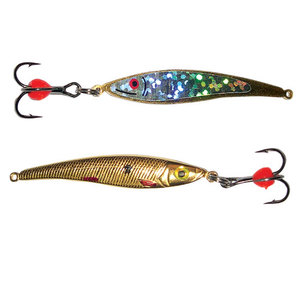 They paint the spoon with various oil-based paints that are durable when constantly immersed in water. Sometimes anglers use for this colored insulating tape... In the arsenal of a fisherman there should be several types, painted in different colors, spoon baits. They paint the spoon with various oil-based paints that are durable when constantly immersed in water. Sometimes anglers use for this colored insulating tape... In the arsenal of a fisherman there should be several types, painted in different colors, spoon baits.
It is believed that the main colors for zander are white and red. But it is impossible to say with confidence that a predator will not be caught in other shades. Sometimes, to resume a stopped fishing, it is enough just to change the color of the bait and the fish, attracted by the novelty, will definitely fall for the bait.
The constant rule is prophylactic tinting of spinners, keeping them in their normal form, paint peeling in places can frighten off the pike perch, which will float away.
Hunting for walleye, like any other predator, is very exciting. Using the right equipment and using the right lures will make this a permanent hobby.
|












 There are walleyes in the river pits of the fairway or in deep places with a clay bottom. He loves to live in places of sunken snags and parts of trees, bottom stones. A favorite place can be considered whirlpools, the vicinity of dams. In roast
There are walleyes in the river pits of the fairway or in deep places with a clay bottom. He loves to live in places of sunken snags and parts of trees, bottom stones. A favorite place can be considered whirlpools, the vicinity of dams. In roast  It is very difficult to answer the question about the time of the appearance of these devices, the only true fact is the antiquity of this invention. Nowadays, they come in many varieties in size, color, shape and mode of movement.
It is very difficult to answer the question about the time of the appearance of these devices, the only true fact is the antiquity of this invention. Nowadays, they come in many varieties in size, color, shape and mode of movement.  In order to
In order to  Such spinners are found in fishing shops oval or elongated with a surface treated with a matte or shiny composition. The spoon is effective in the evening in poor lighting, or applied on a cloudy day. For branded models of this type, you will have to pay a lot of money in the store, but it is much more interesting to make at least one spoon with your own hands.
Such spinners are found in fishing shops oval or elongated with a surface treated with a matte or shiny composition. The spoon is effective in the evening in poor lighting, or applied on a cloudy day. For branded models of this type, you will have to pay a lot of money in the store, but it is much more interesting to make at least one spoon with your own hands.




